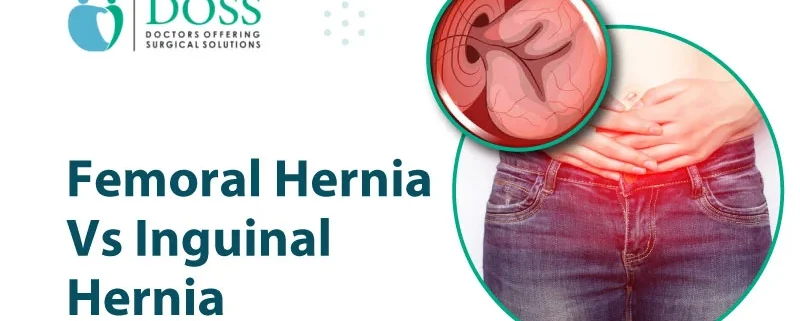Understanding the Differences Between Femoral Hernia vs Inguinal Hernia
Blog
Hernias occur when an internal part of the body pushes through a weakness in the muscle or surrounding tissue wall. Understanding the various types of hernias is crucial in the medical field, as it aids in accurate diagnosis and appropriate treatment.
Distinguishing between femoral hernias and inguinal hernias, in particular, is vital because their proximity in the body can make identification challenging. Yet, each type requires unique clinical approaches to reduce potential complications and to tailor patient care effectively.
Overview of Hernias
The most prevalent types of hernias include
- inguinal,
- femoral,
- umbilical, and
- hiatal hernias,
each with its distinct location and potential risk factors.
Inguinal hernias are the most frequently encountered, occurring predominantly in the groin area where the thigh meets the pelvis. Femoral hernias, although less common than inguinal hernias, present a significant concern as they emerge just below the inguinal ligament and are more often seen in women.
Both types of hernias can exhibit similar symptoms, thereby mandating a thorough clinical evaluation for proper differentiation and management.
Anatomy of the Femoral and Inguinal Regions
The human body’s structure is intricate, and the abdominal wall is no exception. The inguinal region is anatomically defined by the inguinal ligament, a band running from the pubic tubercle to the anterior superior iliac spine.
This area houses the inguinal canal, which, in males, allows for the passage of the spermatic cord, and in females, the round ligament. Due to natural weakness at this passage, part of the intestine can protrude, leading to what is known as an inguinal hernia.
Immediately inferior to the inguinal ligament lies the femoral canal, which is bordered by the femoral vein and artery. This canal is typically very narrow but may widen under certain conditions. It acts as a potential site for the protrusion of abdominal contents, creating a femoral hernia.
Such events are often precipitated by increased intra-abdominal pressure, which could be due to heavy lifting, persistent coughing, or even straining during bowel movements.
The specific anatomical features of the femoral area, including its proximity to the vascular structures and its smaller size, make femoral hernias less common but potentially more severe when they do occur.
Femoral Hernia: Characteristics and Causes
A femoral hernia is a type of hernia that develops in the femoral canal, an area located just below the inguinal ligament and alongside the femoral vein and the femoral artery. This type of hernia is particularly distinguishable by its position, occurring where the abdominal contents push through a weak spot in the surrounding muscle wall and protrude into the femoral canal.
Though they are less common than inguinal hernias, their proximity to major blood vessels makes them a notable concern, particularly because they may become strangulated, leading to serious complications.
Anatomically, the femoral canal is narrower than the inguinal canal, and it is designed to accommodate a lymphatic channel, not intestinal contents. Due to its narrowness and the rigidity of the surrounding tissue, any herniation here can quickly become painful and dangerous.
The causes of femoral hernias are often related to activities or conditions that increase intra-abdominal pressure. Some of these factors include persistent heavy lifting, chronic coughing, constipation, obesity, and even pregnancy.
These pressures force the abdominal viscera towards any point of weakness, in this case, the comparatively vulnerable femoral canal, culminating in the formation of a hernia.
Inguinal Hernia: Characteristics and Causes
An inguinal hernia is a condition where tissue, such as part of the intestine, protrudes through a weak spot in the abdominal muscles, often appearing as a bulge in the groin area.
Located in the inguinal region, which is the area between the abdomen and thigh, this type of hernia occurs in a part of the abdominal wall known as the inguinal canal.
In males, the inguinal canal is the route through which the testes descend before birth, while in females, it encloses the round ligament of the uterus.
The anatomy of the inguinal canal involves several layers of muscle and fascia, which can become compromised due to natural weakness or strain.
For instance, the internal oblique, transversus abdominis, and external oblique muscles contribute to the strength and integrity of the abdomen, but splits in these muscle layers can result in hernial openings.
Common causes of inguinal hernias include anything that increases pressure within the abdominal cavity such as chronic coughing, heavy lifting, or sudden physical exertion.
Several risk factors such as age, being male, family history, obesity, and certain chronic medical conditions can predispose an individual to the development of an inguinal hernia. Additionally, previous surgeries can compromise the abdominal wall, potentially leading to hernia formation.
Symptoms of Femoral and Inguinal Hernias
While femoral and inguinal hernias share some common symptoms, certain signs can help differentiate between the two conditions.
Inguinal Hernia Symptoms:
- A visible bulge on one or both sides of the pubic bone, which becomes more prominent when standing up, coughing, or straining
- A burning, aching, or dragging sensation at the bulge
- Pain or discomfort in the groin, especially when bending over, coughing, or lifting
- A heavy or dragging sensation in the groin
Femoral Hernia Symptoms:
- A bulge near the groin or thigh that may be more noticeable when standing or straining and less noticeable when lying down
- Severe, chronic pain in the groin or thigh—unlike inguinal hernias, the pain may be persistent
- Discomfort when performing activities that strain the lower body
Differentiating Symptom:
- Femoral hernias are more prone to incarceration and strangulation, leading to severe complications. Sudden groin pain, nausea, and vomiting accompanying a femoral hernia bulge could indicate an emergency requiring immediate medical intervention.
Note: While both hernia types present as bulges, the location differs—inguinal hernias often present closer to the pubic bone, while femoral hernias are typically just below and are less common.
Also Read – How to Prevent Hernia Problem ?
Diagnosis of Femoral and Inguinal Hernias
GI specialist diagnose femoral and inguinal hernias through careful physical examinations and the use of diagnostic imaging tests. During the physical examination, the doctor will look for a bulge in the groin area that magnifies with coughing, bending, or lifting. Specific maneuvers, such as asking the patient to stand and cough, may be performed to further assess the hernia.
Common Diagnostic Tests:
- Ultrasound: This is a non-invasive test where high-frequency sound waves create an image of the groin area to help in identifying the presence and type of hernia.
- CT Scan: A computed tomography scan gives a detailed cross-sectional view of the pelvic area, which can show the hernia and its content, aiding in the differentiation between inguinal and femoral hernias.
- MRI Scan: Magnetic resonance imaging provides high-resolution images and can be particularly useful if the diagnosis is not clear.
- Herniography: Less commonly used, this procedure involves injecting contrast dye into the abdominal cavity to detect the presence of a hernia.
These diagnostic procedures help the doctor to confirm the hernia type and to plan appropriate treatment. Additionally, they can be critical in identifying complications such as incarceration or strangulation, which require urgent attention.
Also Read – How to Diagnose Hernia ?
Complications of Untreated Femoral and Inguinal Hernias
If left untreated, both femoral and inguinal hernias can lead to serious complications. The most concerning is strangulation, where the blood supply to the herniated tissue is cut off, leading to tissue death. This is a medical emergency and needs immediate surgical intervention. Another complication is incarceration, where the herniated tissue becomes trapped in the groin and can’t be pushed back into the abdomen, causing severe pain and potential bowel obstruction.
Ignoring symptoms and delaying treatment increases the risk of these complications, making it crucial for individuals to seek medical advice promptly upon noticing any signs of a hernia. Timely intervention not only alleviates discomfort but also prevents severe complications that can be life-threatening and require more complex surgical solutions.


 +919011100010
+919011100010 


